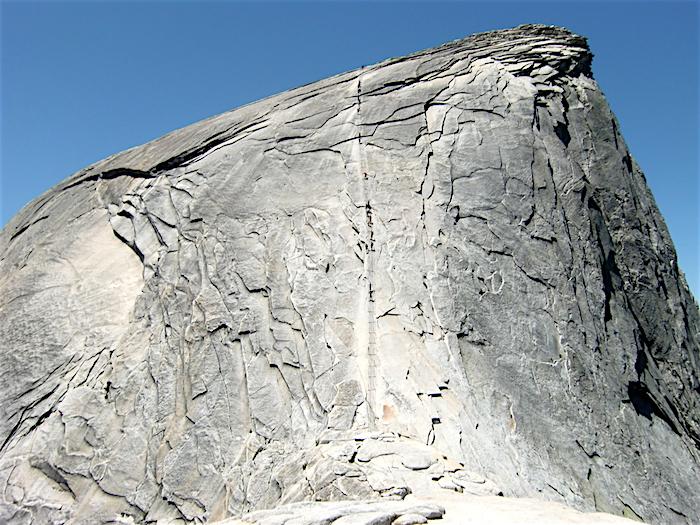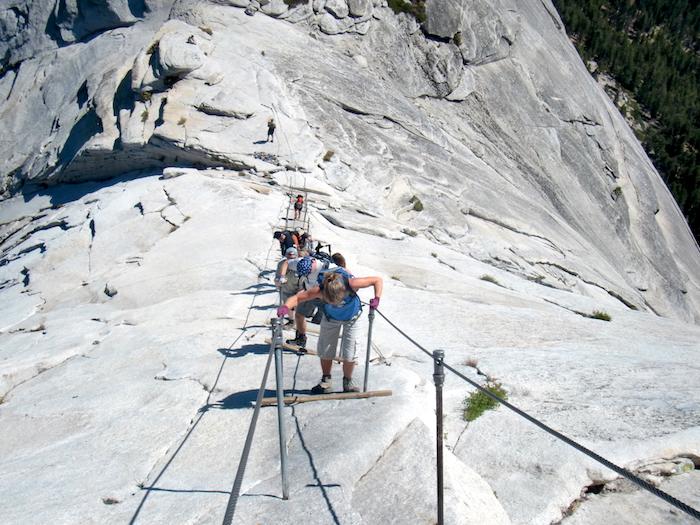
The last pitch to the top of Half Dome is an intimidating one/Rick Deutsch
Most avid hikers know Half Dome. In fact, as the signature landmark for Yosemite National Park, its image is recognized worldwide. It’s even on the 2005 U.S. quarter. From late-May to early-October, visitors can attempt this extremely strenuous 16-mile round-trip day hike. The main challenge is the nearly one mile vertical climb from the valley. Then there’s the final 425 feet, aided by a 45-degree inclined cable banister.
The trail begins in the eastern part of the Yosemite Valley at Happy Isles. A mellow 40-minute walk on asphalt begins your day. The Merced River flows next to you at the beginning of your trek. You’ll see baby strollers and high heels on this warm-up leg. The often damp and strenuous Mist Trail then takes you to the Vernal Fall overlook. This is a perfectly symmetric 300-foot high waterfall. A similar stretch leads up to Nevada Fall, a 600-foot photo op. By now, the crowd thins out. A peaceful walk though the flat Little Yosemite Valley takes you to the forested switchbacks heading to the Half Dome rock itself.
After seven miles from the start, you arrive at Sub Dome, at the shoulder of Half Dome. This is an often unmentioned challenge of 400 tight, twisting granite steps. Once you conquer that, you next face the famous cables. Some reconsider the task at hand and turn around. An early start of the day will keep you ahead of the crowds that build before noon. If you continue on, you change from hiker to climber. Good boots, sticky gloves, and upper body strength are needed. It is hard, but the views are superb. The top covers about 17 football fields. You’ll see the sights of the Yosemite Valley almost 5,000 feet below.
The trip back down the trail to your lodging will not be much faster than your ascent. You are on a good trail, but it is wilderness and you’ll be navigating many uneven granite rocks and slippery gravel. Don’t be tempted to run down; your knees will explode.
With good boots, hiking poles, and water treatment gear, this hike can be done by anyone who trains for it. Education, preparation and motivation are essential. You’ll see folks from 8 to 80 on the trail; it’s fun for all ages. Pack a flashlight in case you are slow and don’t make it back before dark. Cell phones work up top if you need emergency help.
A lottery limits the number allowed to go up the cables. Rangers check permits to help control crowds. The lottery period is in March each year via recreation.gov. Currently, a $4.50 non-refundable application fee is required. Winners are announced in mid-April. Two-hundred-twenty-five permits per day are available for $8 per person if you win. To deter scalping, permits may not be sold by individuals.
If you don’t win the main lottery, the park makes available a minimum of 50 permits via a mini-lottery all summer. You need to apply two days before your desired hike. You will be notified the next day if you won. You may then hike the following day. If you get a wilderness permit, you can also request one of the 75 permits for this category. No permits are available in the park.
All permits are good only for the date awarded. If you cancel up to two days before your hike, you can get a refund of the permit cost. Other than that, there are no refunds for weather or other reasons. They cannot be exchanged for another day.

Climbing to the top of Half Dome is not for the meek or those afraid of heights/Rick Deutsch
The ranger at Sub Dome will not restrict you from going up the cables. You are in the wilderness, so YOU decide if it’s safe to go on. Assess the risk, and then deal with it. Keep off the rock if there is any weather or dampness. The trail is well-marked and very popular – just follow the people in front of you!
The top is 8,842-feet high and is generally well below any concerns for altitude sickness. But do not attempt this when there is thunder or lightning in the area. Half Dome gets hit every month of the year.
Rick Deutsch lives in San Jose, California. An avid adventure traveler, he has done the Half Dome Hike 41 times. He’s known as “Mr Half Dome.” His book: One Best Hike: Yosemite's Half Dome is a great resource that will assist visitors in their preparation. Visit his comprehensive website at www.HikeHalfDome.com.



Comments
In the preseason lottEry you can apply for up to 6 passes. If you win, you get what asked for. As to odds going down if you request 2 or more slots its not surprising. You are only allowed to apply for one. Full rules at recreation.gov.
I have made two trips to the cables in 2016 as a 59 year old man. I trained very hard for this hike. The first trip in July, we got the the cables but the weather turned us away. All I could think was Sh*t! I have to make this hike again. The second time, we got a last minute permit, and left Happy Isles at midnight on the night of the Blood Moon in September. I could not believe how many crazy folks were doing the same thing overnight. We got the the cables in the very early morning (still dark) and ascended as the dawn was brightening. We got to the top of Half Dome and watched the sun rise. I think that this is the most spectacular thing that I have ever seen in my life. I know that is was the hardest physical thing I had ever done, and I am hooked. I will make another attempt at Half Dome this year, and every year that I am able. My advice to folks is a lot of hard hiking, with a lot of elevation gain. The hardest part is the down. Upper body strength is paramount. I used every bit that I had to ascend and descend the cables. I'm thankful that I used a harness and via ferrata rig so that I could clip in and rest on the descend. There was a couple of times on the descent where I was having trouble gripping the cable. It was so satisfying to make it, and it was extra special that I did both trips with my son!
Congratulations, Stephen Hanson. Sounds like a lifetime experience and well earned.
I'm only 8 years older than you, but have sufficient infirmities to acknowledge that I will never be able to accomplish what you have here. I'm very glad to be able to read accounts like yours to appreciate some of what I will miss. Thanks very much for writing here.